Brian Murphy's Blog, page 7
March 29, 2025
Gene Wolfe is intimidating. The Knight is not. I also recommend smoked brisket.
I’ve got a Gene Wolfe sized hole in my reading.
Wolfe is generally accorded of the most respected and literary fantasy authors--ever. Readers are enthralled by his fierce intelligence, incredible imagination, vivid world building and 3D characters. But even his most ardent fans acknowledge he can be tough, reading his stories not unlike grappling with water or a Brazilian Jiu Jitsu master. Half of the reviews of The Book of the New Sun are people who don’t seem to understand what’s going on yet declare that “you have to read this.”
Weird.
As for me, I read the first Book of the New Sun, The Shadow of the Torturer, some 10-12 years ago. Read is perhaps generous; I muddled through, and after closing the cover was left puzzled—not defeated, but feeling like I didn’t grasp it all and probably needed a second attempt. I’ve enjoyed a few of Wolfe’s short stories and deflected off few others; “The Sailor Who Sailed After the Sun” in Grails: Quests of the Dawn left me scratching my head and disappointed, but “A Cabin on the Coast” from the Year’s Best Fantasy 11 was terrific. I also liked “Bloodsport (not the one with Jan Claude van Damme) in Swords and Dark Magic well enough.
The best thing I’ve read by Wolfe is his essay “The Best Introduction to the Mountains,” a moving and poetic elegy to JRR Tolkien that you can read online in its entirety. Wolfe blends a poem by Robert E. Howard into the piece, S&S fans. Writes Wolfe of Tolkien’s greatest literary legacy, “Freedom, love of neighbour, and personal responsibility are steep slopes; he could not climb them for us—we must do that ourselves. But he has shown us the road and the reward.”
Check it out.
But as for his fiction… I’m decidedly mixed. Wolfe loves unreliable narrators and I’m generally not a fan of this device which perhaps explains my ambivalence. But I haven’t given up on Gene, and so decided to have another go with what others have described as his most accessible work—his The Knight and The Wizard, two novels often published together.
I’ve begun reading The Knight. And am happy to report, it’s fantastic. Teenage boy is transported into a magical realm and an encounter with a lusty sprite transforms him into powerful man, and a knight, Sir Able of the High Heart. It’s a straightforward narrative… yet there are clear Wolfe-ian undertones of, a lot more going on under the surface than our narrator understands.
I’m not quite halfway through and will have a review up here on the blog later.
***
In other happy news Spring has finally arrived in New England. I broke out the smoker yesterday and made a brisket that was decidedly on-point. And enjoyed it with my father. No sides necessary, other than beer. I'm getting better with the smoker, which really comes down to low and slow. All good things take time to make.


 So, on this great journey into the East, straight meat was the bill of fare, ammunition and tools principally made up the load on the sled, and the time-card was drawn upon the limitless future. -- Jack London
So, on this great journey into the East, straight meat was the bill of fare, ammunition and tools principally made up the load on the sled, and the time-card was drawn upon the limitless future. -- Jack LondonMarch 25, 2025
Facebook ripped me off
I punched my name into this handy plagiarism detection tool published by The Atlantic, and like millions of other authors discovered Mark Zuckerberg ripped me off. The nerve of this douche!
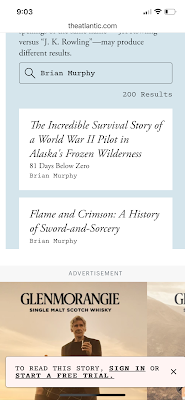 There I am! Above the whiskey. Of which I now need a few shots.
There I am! Above the whiskey. Of which I now need a few shots.In case you missed the recent news, “Meta and its founder and CEO Mark Zuckerberg deliberately and explicitly authorized a raid on LibGen—and Anna's Archive, another massive digital pirate haven—to train its latest AI model.” Millions of books have been ingested into Llama 3 without author compensation, or even notification.
What makes it even worse is that the fine folks at Facebook (I almost wrote that without a sneer) could have put some thought into the decision. Taken a few extra weeks to do the right thing. But instead chose to behave like Somali pirates operating on the open ocean.
What the fuck, Zuck.
There is of course complexity to this. How does fair use apply to the output of generative AI? Is feeding a machine training data the equivalent of a person reading? Will slowing AI development with more rigorous author protections and safety guardrails put us behind foreign competitors like China?
But that’s a battle for someone else to fight. Me? I’m tired of the techo-obfuscation and the excuse-making. This is pretty close to outright theft. Facebook could have done this the legal and proper way but its leadership team chose to operate like immoral assholes. Which should surprise no one.
I've written before that I'm not a fan of generative AI, even though I believe it has incredible potential and is here to stay. It’s just beyond galling that big companies like Meta and OpenAI scrape data from wherever and whomever they want and then sell it back to you in the form of subscription products. And then rigorously defend their own gated fiefdoms with impenetrable legalese and teams of lawyers.
The moral of the story: Laws don’t apply to big companies like they do individuals.
Honestly I am not THAT pissed. Just looking on, feeling bemused, disappointed and disempowered, sort of like the victim of a drive-by egging. Perhaps Llama 3 will now create some kick ass S&S haikus using the genre elements I outline in Flame and Crimson. Maybe there will be a class action suit and I will be entitled to a $3.87 payout after the lawyers take their share. We’ll see.
March 21, 2025
The Rage, Judas Priest
It's a testament to the greatness of British Steel that a song as good as "The Rage" is buried deep on side 2. Wait, do people still refer to albums, and sides? I do.
There is a reason this album is a stone-cold classic. To use a sports analogy its bench is deep ... I don't think it has one weak track and it all sounds awesome, songs stripped down to bare steel. You will find an album "none more metal," to paraphrase one Nigel Tufnel.
The start of "The Rage" is quite unexpected, a funky solo bass intro followed by a jazzy, swinging drum beat that lulls you in to a false sense of security. Where's the rage?
But wait, it's coming. An angry, fist-thrusting metal assault, pounding beat and heavy guitar backed by Rob Halford's soaring vocals.
The breakdown at the end with the rapid fire (snare? I'm not a musician) is divine. It sounds like a machine gun. See 4:06 of the below video.
Maybe it is. Happy Metal Friday.
When we talk with other men
We see red and then
Deep inside our blood begins to boil
Like a tiger
In the cage
We begin to shake with rage
March 20, 2025
The Ring of the Nibelung/Roy Thomas and Gil Kane
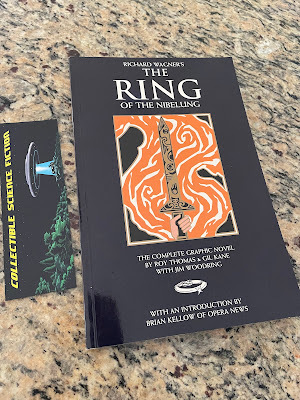 The Ring is mine!Over the course of my lifetime I’ve been exposed to Richard Wagner’s The Ring of the Nibelung in many and various ways. The story, or pieces thereof, from the Old Norse literature upon which the operas are based. The thematic content from modern works like The Broken Sword and The Lord of the Rings. Even the music, which I’ve heard in various and sundry films including Apocalypse Now ("The Ride of the Valkyries") and Excalibur (“Siegfried’s Funeral March” and “O Fortuna,” among others).
The Ring is mine!Over the course of my lifetime I’ve been exposed to Richard Wagner’s The Ring of the Nibelung in many and various ways. The story, or pieces thereof, from the Old Norse literature upon which the operas are based. The thematic content from modern works like The Broken Sword and The Lord of the Rings. Even the music, which I’ve heard in various and sundry films including Apocalypse Now ("The Ride of the Valkyries") and Excalibur (“Siegfried’s Funeral March” and “O Fortuna,” among others).But I haven’t ever seen the opera nor read a full literary treatment of the work. And was overdue to scratch this niggling itch … but wanted to have some fun, with a low bar to entry. And so, I scooped up a treatment I did not know existed until quite recently: Richard Wagner’s The Ring of the Nibelung, the complete graphic novel as adapted by the great Roy Thomas and Gil Kane, with Jim Woodring.
This was enjoyable. I plowed through it in just a few hours over a few nights. It’s a product of DC Comics, released in 1991, and checks in at a relatively hefty 191 pages. It includes some welcome introductory material, including a foreword introducing the biography and talents of the authors, and an introduction to Wagner’s opera cycle by Brian Kellow of Opera News.
The Ring of the Nibelung is a somewhat complex story, with four acts/operas (Wagner prefers music dramas) spanning long periods of time, told through different sets of characters ranging from gods, giants, and dwarves to the heroic albeit mortal race of humans known as Nibelungs. It starts with the creation of the world, and ends with its downfall at Ragnarok. The centerpiece is the story of Siegfried, a mortal hero sent to slay a dragon, reclaim the gods' stolen gold and rescue the Valkyrie Brunnhilde. These stories are bound together by a golden ring that grants its wearer dominion over the world. Yes, there are some Tolkien parallels here, which JRRT denies and to be fair he likely drew on Wagner’s common influences, not the operas. But we’ve got a greedy dragon hoarding wealth, a precious ring fought over by two brothers (one of whom kills the other to take it for himself), a broken sword reforged, and many other familiar elements.
Overall it's a gorgeous, epic, deeply thematic story well told by Thomas—and as you’d expect from his pen, it moves. Kane’s artwork is marvelous, beautiful, comic booky and muscular but not garish. The men are jacked and the women beautiful. Rather than me attempt to word-paint here are some of the panels:
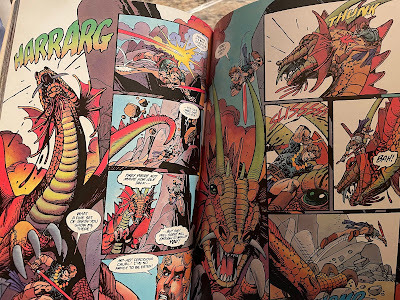
What does it all mean? There’s a lot to dig into, too much for me after one rapid reading of an adaptation in graphic novel form. But The Ring is undoubtedly a Great Story, and like all great stories contains truth. I’m quite fond of Sir Roger Scruton’s “Reflections on The Ring of the Nibelung,” which he describes as a story for “modern people, for whom the path to heroism is overgrown.”
From that essay:
Wagner’s story of gods and heroes, of giants and dwarfs, is not a fairy tale. It is addressed to modern people, who have lost the ways of enchantment, and for whom the path to heroism is overgrown. It is a story in which law and love, power and property are all caught up in a life and death struggle between the forces that govern the human soul.

Love without power will not endure, and power without law will always erode the claims of love. We live this paradox, and without the gods to maintain the moral order the burden of it falls entirely on our shoulders.
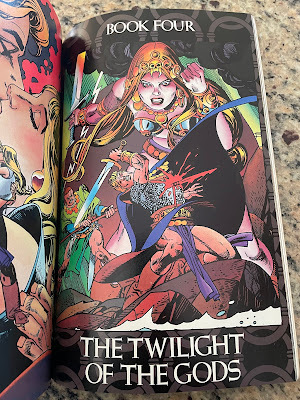
Gods come and go; but they last as long as we make room for them, and we make room for them through sacrifice. The gods come about because we idealize our passions, and it is by accepting the need for sacrifice on behalf of another that our lives acquire a meaning. Seeing things that way we recognize that we are not condemned to mortality but consecrated to it. Such, in the end, was Wagner’s message. Yes, the gods must die, and we ourselves must assume their burdens. But we inherit their aspirations too: freedom, personality, love, and law. There is no way in which we can achieve those great goods through politics, which, if we put too much faith in it, will inevitably degenerate into the kind of totalitarian power enjoyed by the dwarf Alberich. But we can create these things in ourselves, and we do this when we recognize the sacred character of our joys and sufferings, and resolve to be true to them.
For more reading and listening, check these out:
Reflections on “The Ring of the Nibelung”
Wagner Götterdämmerung - Siegfried's death and Funeral march Klaus Tennstedt London Philharmonic
March 15, 2025
The Empress of Dreams—an (overdue) appreciation of Tanith Lee
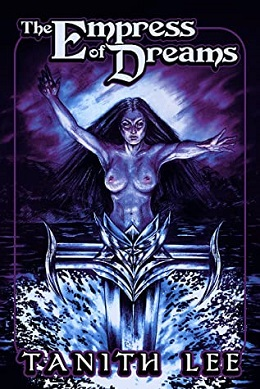 I don’t write fiction, but I’ve read enough of it to make some observations about what makes for good writing. Here’s one: Good writing results from knowing what to emphasize, and what to leave out.
I don’t write fiction, but I’ve read enough of it to make some observations about what makes for good writing. Here’s one: Good writing results from knowing what to emphasize, and what to leave out. Poor writing is usually not the result of a bad idea, nor even of clumsy or artless style. Rather it suffers from being bogged down in needless detail, not placing proper emphasis on the right things. Good storytellers know where to aim the lens. When to let it linger, and when to move it along. Then comes inventive plot, believable character, and good word choice and style. In no particular order.
Tanith Lee is such a storyteller. She’s a writer of atmosphere and romance and decadence and depth who accomplishes this with an economy of words that astonishes. She seems to have an unfailing instinct for what is boring (what to leave out), what keeps the story moving (what to emphasize). Lee then harnesses these principles to a wonderful and unique style that makes every word a pleasure, the act of reading immersive. Dense yet somehow elegant, evocative, lush, and dreamlike. A master of the craft.
The result is that a short story collection like The Empress of Dreams moves, and contains multitudes.
This 2021 collection from DMR Books includes16 stories written over the course of Lee’s career, the earliest from 1976 (“The Demoness,” originally published in The Year’s Best Fantasy Stories 2), and the latest 2013, just two years before her death (“A Tower of Arkrondurl,” originally published in Legends: Stories in Honor of David Gemmell). All can be grouped loosely as sword-and-sorcery. There are some who seem to want beefcake heroes and epic battles and slaughter out of S&S. You don’t get that here. What you do get is dark magic. Atmosphere. The true weird, displacement and strangeness in quasi-medieval settings that derived from Lord Dunsany and Clark Ashton Smith and continued through to Jack Vance and Michael Shea. For modern comparisons, look to the likes of Schuyler Hernstrom or John Fultz.
Some of these stories are S&S through and through. Mercenaries in search of gold, a hot meal, or a new start in life. Warriors encountering strange towers. Everything is small stakes (well, if you count your life as small stakes). But there’s also deep symbolism, engagement with themes and the human condition. “The Woman in Scarlet” explores the fickleness and disloyalty of women in a frank albeit oblique way—it’s told from the vantagepoint of a female sword--that I think a man would have trouble writing. Fearless, edgy stuff. “Odds Against the Gods” is about a young woman in search of her past, and her identity. Lee writes strong men and women in her stories, lusty and brave and three dimensional. Four pages into this collection a woman is enjoying the pleasures of another woman, and later on the attentions of a man. If this type of thing offends you, sorry? Look elsewhere.
I haven’t even mentioned her imagination which at times seems unshackled from the earth. In “The Pain of Glass” Lee conjures a story about a goblet spun from a patch of desert on which a dying woman is separated forever from her true love. Part of her ethereal voice and spirit is absorbed into the sand and later heated and molded into a glass that seeks its soulmate, traveling from hand to hand over years. Those who drink from it are changed:
“Is the cup ensorcelled?”But again, what unites all of these disparate stories is terrific writing. Here’s how Lee renders the changing face of an arrogant town guardsman, whose veneer of invulnerability crumbles beneath the insult of an insouciant outsider who refuses to be intimidated:
“I cannot definitely tell you,” Jandur answered. It was a fact, he could not.
“It is—what is it?”
“Alas, I cannot say. Mystical and magical certainly.”
“Does it affect all—who—touch it?”
“In various ways, it does. Some weep. Some blush. Some begin to sing.”
“And you,” said Razved, with another warning note suddenly entering his voice; that of jealousy, “what do you feel when you take hold of it?
“Fear,” Jandur replied simply.
“Ah,” said Razved. “It is not meant for you, then.”
Razibond’s face was now a marvellous study for any student of the human mood. It has passed through the blank pink of shock to the crimson of wrath, sunk a second in superstitious, uneasy yellow, before escalating into an extraordinary puce—a hue that would have assured any dye-maker a fortune, had he been able to reproduce it. More than this, Rozibund had swollen up like a toad. He cast his wine cup to the ground, where it shattered, being unwisely made of clay, and, disdaining his knife, heaved out a cleaverish blade some four feet long.Wonderful.
Admission—I had read Lee prior in the likes of Swords Against Darkness, The Year’s Best Fantasy Stories, and Amazons, which I re-read while researching and writing Flame and Crimson. But I’ve never any of her many novels, of which she’s written more than 90(!), nor a collection. This was a mistake. I think she is close to a first rank S&S writer. She’s that good. In fact she might now rank as my favorite female S&S writer. I feel that strongly after reading this collection. C.L. Moore’s best short stories (Black God’s Kiss, Shambleau, Hellsgarde) and Leigh Brackett’s The Sword of Rhiannon are as good or arguably better as anything in here but The Empress of Dreams as a whole is in incredibly diverse and strong all the way through, hit after hit or at least strength to strength.
Lee’s literary debt to Vance is evident and admittedly her greatest influence, and so it is appropriate that the collection ends with “Evillo the Uncunning,” which originally appeared in Songs of The Dying Earth: Stories in Honor of Jack Vance (2009). This story ends with Lee’s short appreciation of Vance, in which she writes, “I don’t quite believe Jack Vance invented the Dying Earth. Part of me knows he’s been there. Often.”
Lee seems to be having a bit of a resurgence these days due to the Neil Gaiman controversy, which has brought to light Gaiman’s liberal borrowing from Lee’s flat earth stories. No one would have a problem with this had Gaiman admitted as much; Lee certainly admits to her own great indebtedness to Vance, for example. The fact he has seemingly never admitted to Lee’s influence does him no honor. See more here.
What criticisms do I have of this collection, if any? Lee loves open-ended endings perhaps a little too much. Not all her stories do this, but enough fall into the category of leave it up to the reader to figure out the meaning. I’m of a mixed mind of these types of stories; it can rob them of impact, leaving you with the feeling you’ve read something unfinished, scratching your head. But these are also the sort of stories that stay with you; you are made to put the pieces together and assemble the meaning, and when you do, you participate in the story. And it lingers. As this collection does.
March 9, 2025
We're living in an outrage machine
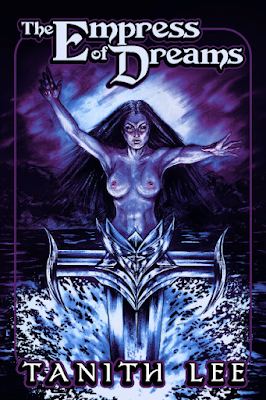 Tanith Lee = anti-outrage.Ronnie James Dio once sang that you’re living in a time machine. Today we’re all living in an outrage machine. I don’t like it … yet here I am, in the machine, expressing my outrage.
Tanith Lee = anti-outrage.Ronnie James Dio once sang that you’re living in a time machine. Today we’re all living in an outrage machine. I don’t like it … yet here I am, in the machine, expressing my outrage. Outrage sells, and consumes.
I am old enough to have worked in a pre-internet era. As a newspaper reporter I conducted interviews with a hand-held notebook. Typed the stories into a computer disconnected from the internet. Formatted the stories into columns, printed them out. Then with Xacto knife and wax created pages that were shot with a camera and eventually printed.
And there was your newspaper. I even delivered them for extra cash.
Yes I’m a dinosaur.
As quickly and efficiently as we worked this process took time. A breaking story would need at least 12 hours to make it into the next edition. Newspapers and nighttime television were our primary mechanism for consuming the news. There was a sane rhythm to it, a chance to consume and discuss. Or ignore it altogether.
Then, like today, stories provoked outrage. But the way to express it was to vent to your significant other, or your friends over a beer at the bar. Then you went back to the real world.
That model is long dead. Newsprint and ink were replaced by cable news, which in turn has been replaced by ubiquitous, permanently connected devices, fueled by algorithms which serve up outrage 24-7.
We read outrageous things, post angry comments, people shout back and attempt to “own” each other.
Balanced reporting that took some modicum of measured thought has been replaced by polarized information.
There are advantages to screens and 24-7 news cycles and social media. Speed of reporting and dissemination. More perspectives. But it comes with a cost.
Algorithms manipulate our emotions by showing us viral posts of outrage and angry comments. These clicks drive ad revenue. And so we’re being fed a lot of outrage. Overfed.
There’s too much of everything. Endless scrolling is not only possible, it’s incredibly easy to fill hours.
Yes, there are corners of sanity online, good people doing good work. But the algorithm doesn’t prioritize these. It takes work to find them.
Somehow we need to break the cycle and take back our attention. Focus on the things that matter. And stop walking around staring at our machines, distracted. And outraged.
Do you feel this? I do. And yet I find myself doom scrolling, time and again. Beat myself up over it and promise to do better next time.
One way to break the cycle is through sustained, offline reading. I’m currently reading Tanith Lee’s The Empress of Dreams and it’s conjured a wonderful spell in my mind of somewhere else. A place of danger and dark fable and the weird and unexpected, happily somewhere else than online hell.
Your thoughts (and outrage) are welcome as always.
March 7, 2025
Sign of the Southern Cross, Black Sabbath
March 3, 2025
Martin Eden (1909), Jack London
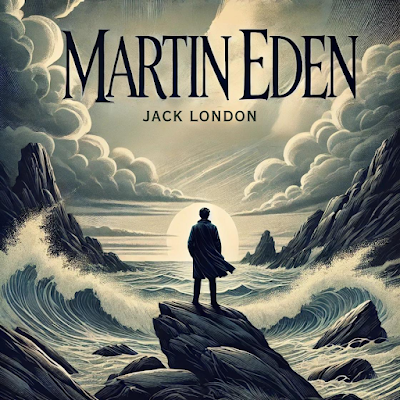 A great voyage of the soul...Jack London is a great writer, full stop. Upon reading Martin Eden (1909) I declare he now resides firmly in my top 10 favorite authors. A list still in progress and subject to change but probably looks something like this (not in any order):
A great voyage of the soul...Jack London is a great writer, full stop. Upon reading Martin Eden (1909) I declare he now resides firmly in my top 10 favorite authors. A list still in progress and subject to change but probably looks something like this (not in any order):1. JRR Tolkien
2. Robert E. Howard
3. Jack London
4. TH White
5. Stephen King
6. Ray Bradbury
7. Bernard Cornwell
8. Poul Anderson
9. Karl Edward Wagner
10. HP Lovecraft
Reading London is akin to receiving an electric shock. The intensity with which he writes is almost unrivaled. In fact, there’s really only one author I’ve encountered who writes with the same poetic, romantic verve, great splashes of color and blood and rage and wild passion: Robert E. Howard.
I didn’t necessarily think Martin Eden would deliver the same visceral experiences as The Call of the Wild, The Sea Wolf, or The Star Rover, but as it turns out, it did. These are mostly contained in the heart and mind of the titular protagonist Martin Eden, though there are some all-time great fistfights. But even with no swordplay or sorcery, I literally aloud mouthed, “god damn” after reading various lines and passages. Probably at least a dozen times.
Why read Martin Eden if you a sword-and-sorcery fan, or a fan of REH?
Howard was directly influenced by London, in all ways.
If you want to know how Robert E. Howard felt, read Martin Eden.
If you want to know how Howard wrote, read Martin Eden.
How Howard struggled with life, with relationships, with his disappointment for the world--it’s all here, in this book. Martin Eden is almost as vital to understanding Howard as his personal correspondence, or One Who Walked Alone. IMO.
How can I make such a wild declaration? Martin Eden was the chief influence on Howard’s own autobiographical novel, Post Oaks and Sand Roughs. It likely influenced Howard’s life choices and how he viewed himself, too. REH scholar Will Oliver does a nice job tracing these influences in his essay “Robert E. Howard and Jack London’s Martin Eden: Analyzing the influence of Martin Eden on Howard and his Semi-Autobiography” (The Dark Man: Journal of Robert E. Howard and Pulp Studies, Vol. 11, Issue 1, June 2020). Which I sought out and read after finishing the book.
Martin Eden is a writer, a frustrated romantic, a boxer. He worked long hours in soulless jobs while wanting to do something else. The book is a story of romance colliding with commerce. Just as Howard was foiled by the whims of magazine publishers and the late payments of Weird Tales, so too is Martin Eden consumed with these struggles, living on the edge of poverty and needing to work back-breaking jobs that left him too tired to write. Yet he pressed on, because he refused to let passion and truth succumb to conformity and mindless work.
But it’s a brutal struggle, and a tragedy, just as Howard’s life was.
Martin Eden is many other things besides. A critique of early 20th capitalism, its long and inhumane working conditions. A critique of class, the cultural elites who look with scorn upon the working-class men and women who actually make the world go round. It’s a critique of the weakness of people, who are fickle and disloyal and petty.
Eden’s great love, Ruth, abandons him when he needs her most. When he finally meets with success the world comes crawling back but Martin sees through the grift and shallowness. He’s like Conan, a barbarian at odds with corrupt civilization. A rough and uncultured sailor, Eden desperately wants to be civilized, and spends the whole book in this pursuit. He makes, it, but at the expense of his soul. When he finally learns of its cultured ways, “the gilt, the craft, and the lie,” it breaks his heart.
“I’m no more than a barbarian getting my first impression of civilization,” he observes.
I won’t it spoil any further, just to add if not already apparent: Martin Eden=Recommended.
February 26, 2025
Rest in peace James Silke
James Silke, best known in S&S circles as the author of the Death Dealer series, recently passed away. He was 93 and lived a full and varied life as a photographer, writer, art director and more.
I'd been slowly working my way through the Death Dealer series and am posting here links to my prior reviews. These unfortunately are not great books, certainly not as good as their fantastic Frank Frazetta cover art ... but they do possess a ridiculous charm of their own, a bit of a "WTF did I just read?" unpredictability that makes them ... notable.
Sword-and-sorcery’s endgame: James Silke’s Prisoner of the Horned Helmet
“This goes to 11:” A Review of Death Dealer Book 2: Lords of Destruction
Death Dealer 3: Semi-enjoyable (?) train-wreck
I'm sure I will get around to book IV.
God speed James Silke!
February 23, 2025
Some recent acquisitions
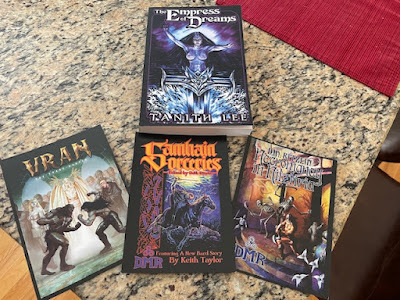 The three other images below are postcard ads included w/Lee volume.
The three other images below are postcard ads included w/Lee volume.About time I picked up Empress of Dreams by Tanith Lee. DMR collected all her tales of S&S in one volume.
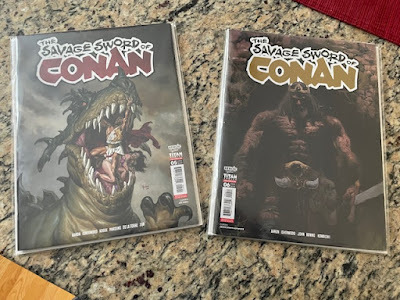
I now have the first six issues of SSOC. I’ve only read the first three of the new run from Titan but plan to read the next three ASAP. Covers are still looking fantastic.

The Trooper is not a great beer, but not bad either. Drinkable, pleasant, reliable British brown ale. And of course it’s all about the can art.
 When My Body’s Numb and My Throat is Dry, I grab a Trooper.
When My Body’s Numb and My Throat is Dry, I grab a Trooper.


